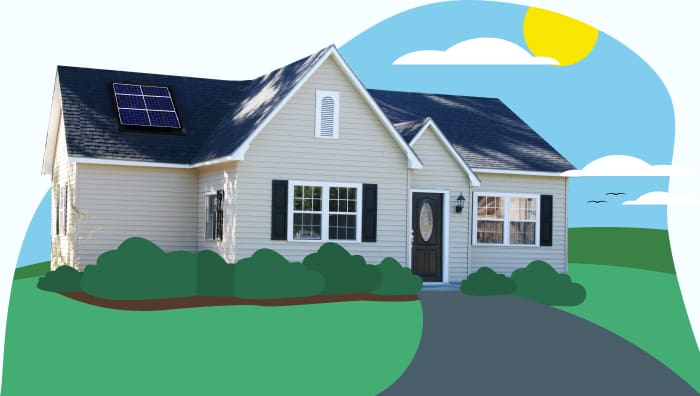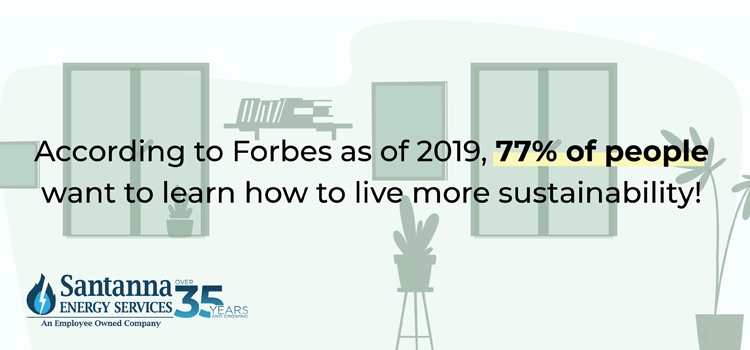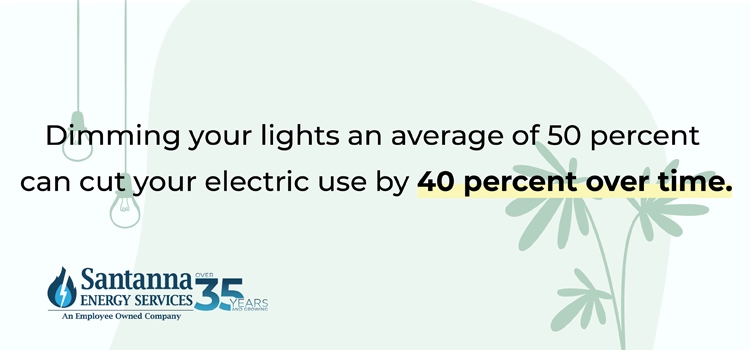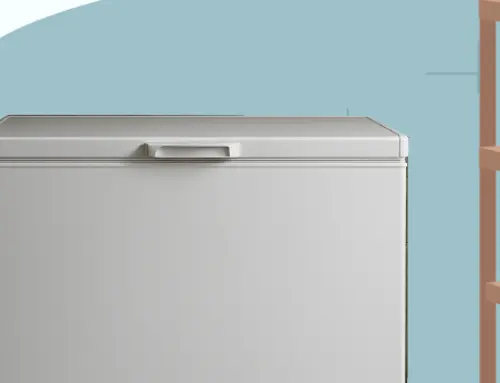The Pros & Cons of Going Green in your Home
by Greg Rabaey
14.1 min read

Going green — or making adjustments to your daily habits and lifestyle in order to live more sustainably — in your home can be an exciting and rewarding experience. Not only will these changes lead to a smaller carbon footprint, but you’ll also save money on utilities while creating a healthier environment for yourself, your family, and the planet.
However, it’s important to understand both the advantages and disadvantages of green living. We’ll explore the ups and downs of going green at home so you can make the best decision for yourself and your family.
What Does It Mean To Go Green
At a high level, going green involves making lifestyle choices with an eco-friendly mindset. But what does that look like within your home? There are several things you can do to create a green household, including reducing your energy footprint, swapping out plastics for reusable items, cutting back on food waste, and conserving water — all of which are part of practicing sustainable living. When done consistently, these efforts can go a long way toward reducing pollution and consumption of resources as well as improving the health of the environment.
Sustainability practices have also found a place in real estate, with green homes gaining in popularity over recent years. These homes are constructed according to sustainable building practices, which include the use of eco-friendly materials and keeping energy efficiency at the forefront of design plans. The resulting residences come with multiple benefits for homeowners, such as improved indoor air quality, lower energy bills, and high resale value.
Advantages of Going Green
1. Less Waste
Going green at home can be a great way to reduce your waste and benefit the environment. Not only will you contribute less to landfills, but when you choose to power your home with clean energy, you’ll also reduce the demand for fossil fuels which are major contributors to air pollution. Cutting back on household waste by reducing and reusing also has positive impacts for the environment. By consuming less, you’ll help prevent the pollution, deforestation, and other environmental harms that are byproducts of harvesting the materials needed to create your products.
2. Living Green Is Cost Effective
As green energy sources become more widely available and cost-effective, you’ll be able to reduce your energy bills by making small changes. Solar panels, wind turbines, and geothermal systems are all renewable energy sources that can provide electricity for a lower price. The savings don’t stop there — financial incentives such as federal tax credits and state-based rebates exist for those choosing to go green at home.
Unplugging electronics, installing rainwater harvesting systems, and replacing older appliances with energy-efficient ones are great ways to reduce the amount of energy your household consumes, leading to lower monthly utility expenses.
3. Improved Health
Green living offers benefits for both your mental and physical health. Not only does it teach you to be mindful and help reduce your stress levels, it also promotes a healthy lifestyle. By making eco-friendly choices — like moving away from carbon-based energy sources, eating locally sourced organic foods, and walking or biking instead of driving — you can help reduce air pollution and improve your overall health.
Similarly, using environmentally friendly HEPA (High Efficiency Particulate Air) filters can reduce asthma and allergy symptoms within your home. By making an effort to live a green lifestyle, you can make a difference and be part of the solution for climate change.
4. Environmental Protection
One significant advantage of running a green household is the positive impact it has on environmental protection. By making sustainability-based choices in your daily life, such as using energy-efficient appliances, reducing water consumption, and embracing renewable energy sources you contribute to the reduction of greenhouse gas emissions. Named for their ability to trap heat within our atmosphere, these gases are a major contributor to climate change and include compounds such as carbon dioxide, methane, nitrous oxide, and a variety of fluorinated gases.
Taking a proactive approach helps mitigate climate change, preserves biodiversity, and safeguards the delicate balance of ecosystems. For example, by choosing to purchase more sustainably grown and harvested foods, you support farming practices that have a positive impact on the environment.
5. Protection of Natural Resources
Going green in your home can also help protect natural resources. One of the most abundant natural resources in your home is water. According to the EPA, the average American family uses 300 gallons of water a day, making water conservation a great starting point for going green. Conserving water not only helps lower your environmental footprint, but it also ensures that this finite resource remains available for future generations. You can cut back on water use in your home by taking shorter showers, fixing leaky sinks, and running full loads in dishwashers.
6. Ethical Consumerism
Going green in your home, or even making small green changes in your daily life, can make you more aware of your purchases and can encourage you to rethink your buying habits. By choosing products and services that are environmentally friendly and sustainably sourced, individuals can make responsible choices for the planet and send a powerful message to businesses. This reinforces the demand for eco-friendly and socially responsible products, thereby encouraging companies to adopt sustainable practices. Ethical consumerism also raises awareness about environmental responsibility and empowers you to choose businesses that align with your values.
7. Community Engagement
Embracing eco-conscious initiatives not only benefits the environment, your home, and lifestyle, but it also fosters a sense of shared purpose and collaboration within a community. Going green in your home can be a catalyst of change for your neighborhood. Starting the conversation about going green and educating others about the eco-friendly practices you follow in your home can encourage collaboration in the community and a shared sense of purpose for environmental responsibility. It’s a win-win for the community and the planet.
8. Going Green Increases Home Value
In addition to helping the environment, going green also comes with financial benefits for homeowners — having environmentally friendly features can increase property values by up to 18 percent. So what does that mean for your property? Some great ways to ensure your home appraises for more while lowering your carbon footprint include:
- Replacing older appliances with energy-efficient models
- Investing in solar panels
- Choosing sustainably-sourced building materials for renovations
- Installing a smart thermostat
- Switching to double-pane windows
Disadvantages of Going Green
1. Going Green Can Be a Big Time and Money Commitment
Going green in your home is a great way to help the environment and save money over the long term. But the conversion takes time and an initial financial investment to get started. Going green is more than just swapping out lightbulbs, it involves integrating more eco-friendly products into your home, such as smart thermostats or rooftop solar panels. Though these additions aren’t cheap, the savings you’ll see on your utility bills and in your home’s valuation, make the switch worthwhile in the long run.
At times, it may feel like going green means taking two steps forward and one step back, but with a bit of perseverance, you’ll reap the rewards of your investment. With renewable energy, you’ll save money over time and help reduce your ecological footprint.
2. Getting the Right Materials Can Be Difficult
Going green in your home can feel like a tall order. One of the major disadvantages is getting the right materials for greening up your space. Sure, renewable energy sources and green products are becoming more popular and accessible, but if you don’t know what you’re looking for, it can be difficult to find exactly what you need. To make “going green” easier, here are a few examples of eco-friendly materials used in green builds:
- Green Steel: Steel manufactured without the use of fossil fuels, typically used in primary and secondary framing elements.
- Recycled Plastic: Plastic made from recycled materials, which can be found in flooring, siding, paneling, and even some bricks.
- Reclaimed Wood: Wood that’s been taken from older buildings and “upcycled” for reuse as flooring, walls, decorative elements, and more.
- Plant-Based Rigid Foam: A polyurethane foam substitute made from a variety of different plant materials which can be found in insulation.
- Clay Brick: Bricks made from natural clay, used for walls, outdoor walkways, and interior decorative elements.
3. Green Infrastructure Might Be Missing in Some Regions
Going green can be a great way to reduce your carbon footprint and live a more sustainable lifestyle, but it’s not always that simple. In some regions, green infrastructure may be missing or limited. For example, if you live in an area without reliable access to renewable energy sources like solar or wind power, then going green might be more challenging. However, green infrastructure is expanding all the time and with enough research, you may be able to find green solutions that are right for your region.
If you’re planning an eco-friendly addition to your home, it’s first important to check with your city to see if any special permits are needed in addition to standard building permits as requirements may vary by municipality. Financing your project is equally important, with available options ranging from traditional mortgages and home equity products to specialized loans for eco-friendly projects.
4. Lack of Awareness and Education
Many individuals and communities may not fully understand the importance of sustainable and green practices or how to implement them effectively. This knowledge gap can lead to resistance, apathy, or skepticism toward eco-friendly initiatives. Moreover, without adequate education, people may not be aware of the various green technologies, products, and solutions available, hindering their ability to make informed choices.
5. Lack of Motivation To Stay Green
Unfortunately, staying motivated to maintain eco-friendly practices on a consistent basis can be difficult. While individuals may initially embrace green habits with enthusiasm, it can be demanding to sustain these efforts over the long term. Motivation may wane due to various factors such as convenience, social pressures, or economic constraints. Moreover, the scale of global environmental issues can sometimes make personal efforts seem insignificant, leading to a sense of futility.
To address this challenge, it’s important to create an environment and community that supports your decision to go green. Ways to do this include:
- Asking family members, friends, and neighbors to hold you — and each other — accountable.
- Setting yourself up for success by starting with small changes before gradually increasing your efforts over time.
- Making it a group effort by inviting others to join you on your sustainable living journey.
6. Going Green Can Come With Compatibility Issues
Each dwelling has its unique structural, architectural, and geographic characteristics that can pose challenges when trying to implement eco-friendly solutions. For instance, older homes may require extensive renovations to meet green standards, which can be cost-prohibitive. Additionally, regional climate variations can make certain green technologies less effective or even impractical in some areas. Moreover, local regulations and restrictions may limit the installation of renewable energy sources or rainwater harvesting systems. These compatibility issues can deter homeowners from fully adopting green practices and materials.
7. Aesthetics and Design Constraints
Sustainable features like solar panels, wind turbines, or rainwater harvesting systems may not always align with the desired architectural aesthetics, leading to concerns about visual appeal. Designing and retrofitting structures to accommodate green technologies can be challenging, potentially altering the overall appearance of a property and may possibly be against your homeowners association’s rules or regulations. Striking a balance between eco-conscious solutions and maintaining a desired aesthetic can be a complex and costly endeavor, and it can discourage some individuals or communities from embracing green practices.
Easy Ways To Go Green at Home
Going green involves much more than only installing solar panels, but it doesn’t have to be intimidating! You don’t have to make major improvements to your home to make the world a greener place. Here are nine ways you can go green at home without breaking the bank:
- Opt for LED Lighting: Replace traditional bulbs with energy-efficient LED lights. On average, LED light bulbs use 75 percent less energy than incandescent light bulbs.
- Embrace Natural Light: Open curtains and blinds to reduce the need for artificial lighting. Unblocked windows let heat from the sun into your home, which can reduce your reliance on heating systems and potentially save you money on your heating bill.
- Use Reusable Products: Replace disposable items with reusable items such as cloth shopping bags and glass water bottles.
- Make Your Own Eco-Friendly Cleaning Products: Homemade cleaners often use simple, natural ingredients like vinegar, baking soda, and lemon juice, which are less harmful to the environment.
- Minimize Food Waste: Plan meals to ensure you aren’t over-shopping at the grocery store and store food properly so it lasts longer.
- Plant Indoor Greenery: Houseplants improve indoor air quality and add a natural touch to your space.
- Unplug and Power Down: Turn off lights, appliances, and electronics when not in use to minimize energy consumption.
- Recycle: Recycling generally requires less energy than producing new products from raw materials.
- Compost: If you have the space, start a compost pile in your backyard. Composting breaks down certain food scraps into a nutrient-rich mulch that can be used to fertilize gardens and improve your soil quality. It’s also a great way to reduce landfill volume.
Home Improvements That Promote Green Living
Going green can take time, but it doesn’t have to be complicated. Here are eight ways you can upgrade your home to make sustainable strides toward a greener lifestyle:
- Install a Smart Thermostat: Smart thermostats are designed to help conserve energy by automatically adjusting the temperature based on your preferences and schedules. In fact, this technology can help you save up to eight percent on your heating and cooling bills.
- Install Energy-Efficient Appliances: These appliances — such as refrigerators, freezers, washers, and dryers — are built to comply with energy efficiency standards set by the EPA. As such, they can significantly reduce electricity consumption in your home.
- Upgrade to Low-Flow Fixtures: These plumbing fixtures use less water than their standard counterparts through reduced flow rates. When installed, low-flow fixtures can help you save up to 2,300 gallons of water a year.
- Improve Your Insulation: Replacing your current insulation with an eco-friendly option such as a wool-, cotton-, denim- or cellulose-based alternative can help regulate your home’s interior climate in a way that fits with a green lifestyle.
- Consider Energy-Efficient Windows: Heat gain and heat loss through windows are responsible for 25–30 percent of residential heating and cooling energy use. Installing energy-efficient windows can help reduce this loss.
- Invest in an Energy-Efficient Water Heater: According to Energy Star, water heaters that are more energy efficient use 70 percent less energy than other models.
- Go With Smart Plugs: Culprits of household energy loss include appliances that remain plugged in when not in use or lights that have been accidentally left on. With smart plugs, users are able to remotely cut power to any devices plugged into them, reducing energy waste.
- Install Motion-Activated Dimmer Lighting: This lighting allows you to use less electricity for lighting and will turn off automatically in unoccupied rooms
How can Santanna Help you Support Eco-Friendly Efforts?
Supporting eco-friendly efforts might seem daunting at times, but here at Santanna, we have solutions that can make going green easier than ever. From the moment you sign up for a plan, implementation of your earth-friendly energy choice is a breeze. Unlike other energy providers, with Santanna, there’s no extra equipment needed and you can start making an impact on the planet as soon as possible.
Santanna has plans that can fit all your energy needs, whether you’re looking for a monthly fixed rate or a plan that lets you use as much energy as you need at one flat supply charge.* In the end, going green in your home is a great way to reduce your environmental impact and Santanna has earth-friendly energy solutions you need to achieve your sustainability goals. Visit us online to check out plans available in your neighborhood.
Santanna Energy Services is a supplier of renewable energy solutions in the United States, providing services to Illinois, Indiana, Pennsylvania, Michigan, and Ohio. We provide a wide range of energy services and products to meet the needs of both residential and small business customers. Our mission is to provide innovative and cost-effective energy solutions that will help our customers achieve their energy goals. With over 35 years of experience, we are committed to creating life-long relationships by providing quality service to customers, communities, and employees.
*Restrictions apply. Enrollment based upon program eligibility. Customers using more than 125% of normal monthly usage as determined by Santanna may be required to switch plans.
Greg Rabaey, the CEO of Santanna Energy Services, is a forward-thinking leader with a wealth of experience in the energy industry. With a solid educational foundation in mathematics, computer science, and physics, including a Ph.D. in Physics from the University of Arizona, Greg's career spans over 30 years in technology and energy. Under his guidance, Santanna Energy Services has evolved into a consumer-centric powerhouse, providing electricity and natural gas to countless homes across the Midwest. Greg's strategic acumen, deep commitment to his team and customers, and passion for innovation have been instrumental in the company's growth. His visionary leadership has led Santanna to become an industry innovator, offering a range of earth-friendly and unlimited energy options, setting new standards in environmentally conscious energy solutions for clients. Beyond the boardroom, he actively contributes to his community, embodying his dedication to driving positive change, both professionally and personally.










